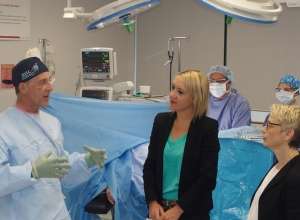Simulation training to improve treatment injury prevention

Treatment injury prevention in New Zealand will benefit from a world leading operating room simulation training programme, developed and piloted at the University of Auckland and to be rolled out to hospitals from next year.
The rollout will be funded by ACC and is one of several measures announced today by ACC Minister, Nikki Kaye, as part of an investment in injury treatment prevention in partnership with the health sector.
The Multidisciplinary Operating Room Simulation (MORSim) team led by Associate Professor Jennifer Weller from the University of Auckland, will lead the initial rollout to District Health Boards.
Training 'champions' within each DHB will work with the MORSim team to build capacity for the training simulation programme within their hospitals, so that these become 'business as usual'.
On Tuesday morning Ms Kaye visited the (MORSim) training programme based at the University of Auckland's Tamaki Campus.
The MORSim training programme aims to develop good communication and teamwork between operating room staff and is uniquely multi-disciplinary; including surgeons, anaesthetists, nurses and technicians in the operating theatre. An evaluation of the pilot programme showed this training could result in a 14 percent reduction in treatment injuries.
"Injury prevention is an important part of ACC's role," says Ms Kaye. "These initiatives to address treatment injuries are testament to how ACC is developing closer relationships with partners, and making better use of the analysis of injury data and evidence-based interventions to help reduce injuries in New Zealand."
"It's exciting to be able to rollout this nationally significant simulation training to multi-disciplinary teams, using this cutting edge technology," she says.
Treatment injury trends show that since 2009, ACC treatment injury claims have increased by 63 percent, from 1.8 claims per 1,000 in 2008/09 to 2.9 in 2014/15. Costs have also increased by 43 percent, from $264 million in 2008/09 to $379 million in 2014/15.
The MORSim training uses complex, challenging scenarios and very realistic surgical mannequins (which can bleed, breathe and be monitored), real drugs and fluids, real equipment and instruments and realistic patient clinical notes.
At the demonstration for Minister Kaye at the University, Professor Weller and surgeon, Professor Ian Civil, emphasised the importance of training as a team, as opposed to the silo approach where each member – surgeons, anaesthetists, nurses etc – train separately.
"We can provide very realistic and technically sophisticated mannequins that model complex operations and scenarios, such as stab wounds, a leg blown off, or a post-operative deteriorating patient, and monitor how team members respond to these situations," says Professor Civil.
"This way we can put real situations in front of clinicians for them to practise in a safe setting," he says. "This cutting edge simulation allows them to practise what they are going to do with real patients and provide the best level of care for people."




















